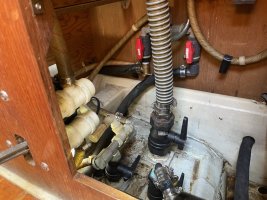If you have had not water in the bilge in a couple of days, then whatever it is only happens when something is running (or it is raining out)... one way to try to diagnose would be to do different things, each time keeping an eye on the bilge.
Yup. First winter I had my boat I was sort of astonished at how much water was in the bilge. I ended up putting a bung in the limber-hole of the TAFG pocket just behind the mast, to isolate that section with an eye toward determining how much was rain-water and how much was something else. It worked. After a rain, forward pocket may have quite a bit of water in it (it's amazing how much water can come down the inside of the mast!), the rest of bilge largely dry.
Since then, as you say, it's a cycle of observe and fix. Noticed that there was water in the main bilge after running at hull speed for a while. Determined that the water was coming up out of the rudder tube. Fixed with some grease applied through the zerk fitting. Noticed there was water in the main bilge after a big rain. Determined that one of the cockpit scupper hoses had a leak. Fixed. Found water under the galley sink. Determined that the .... I don't know what you call it, the drain fitting that goes through the bottom of the sink?... wasn't bedded, and dripped whenever the sink had water in it. Fixed with some plumbers putty (and a new hose while I was there). Etc.
After the last big rain, I found a wet spot about the size of a quarter on the dinette cushion directly under the aft corner of the aft window. Clearly it is telling me it's time to re-bed the windows. So it goes.
It's a constant quest. Substantially less annoying if you decide to make a game of it. Kinda like hide-and-seek, but with water

B




